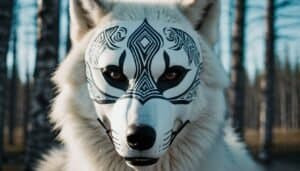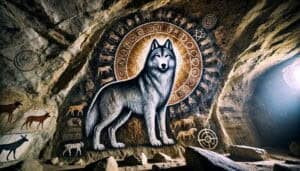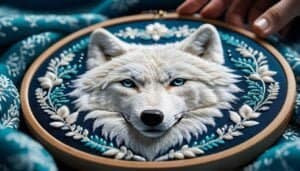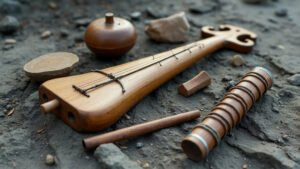Introduction
Arctic wolves, with their striking appearance and cultural significance, have long inspired the creation of intricate and meaningful Arctic jewelry and ornamentation
This article delves into the traditional and cultural influences of Arctic wolves on jewelry designs, exploring the historical background, common motifs, and symbolic meanings. We will also examine the materials and techniques used in crafting these unique pieces, as well as the evolution and modern adaptations of Arctic wolf-inspired jewelry
Throughout, we will highlight how the environment of the Arctic impacts the creation of these beautiful artifacts and the sustainable practices employed by contemporary artisans
Traditional and Cultural Influence of Arctic Wolves in Jewelry
Arctic wolves have a profound influence on the cultural and traditional aspects of Arctic jewelry. Their majestic presence and the deep symbolism they hold in various indigenous Arctic cultures make them a popular motif in traditional ornamentation
Understanding this influence requires a look into the historical context, common motifs, and the cultural beliefs surrounding Arctic wolves
Historical Background of Arctic Jewelry
The history of Arctic jewelry dates back thousands of years, reflecting the rich cultural heritage of the indigenous peoples of the Arctic region
Traditionally, jewelry was not merely decorative but held significant cultural and spiritual value. Materials like bone, ivory, antlers, and stones were commonly used, sourced from the environment and animals integral to the Arctic ecosystem, such as seals, whales, and wolves
Arctic wolves, in particular, were revered for their strength, resilience, and survival skills in harsh conditions. These attributes made them a powerful symbol in the jewelry crafted by Arctic tribes. The designs often incorporated wolf imagery to convey protection, courage, and connection to the natural world
Historical records and archaeological findings indicate that these themes were prevalent in many ancient Arctic societies, with artifacts showcasing intricate wolf motifs and designs
Common Motifs and Symbols
In Arctic jewelry, motifs inspired by Arctic wolves are prevalent and carry deep meanings. Common symbols include the wolf itself, often depicted in various forms such as full-body representations, wolf heads, and paw prints
These motifs are typically carved into materials like bone and ivory or depicted in beadwork and metalwork
The wolf is often shown in a hunting stance or howling, symbolizing strength, unity, and communication. Another common motif is the wolf pack, representing community and familial bonds, crucial aspects of survival in the Arctic environment. These symbols are not only aesthetic but are also believed to imbue the wearer with the traits of the wolf, such as bravery and endurance
Additionally, the use of geometric patterns and natural forms in the jewelry often complements the wolf motifs, creating a harmonious design that reflects the interconnectedness of Arctic life and the environment
Arctic Wolves in Indigenous Mythology
Arctic wolves hold a prominent place in the mythology and folklore of various Arctic indigenous cultures. For many, the wolf is considered a sacred animal, a guardian spirit, and a guide. Myths and legends often portray the wolf as a wise and powerful creature, capable of bridging the human and spiritual worlds
In Inuit mythology, for example, the wolf is revered as a totem animal and is believed to possess spiritual powers
Stories about wolf spirits guiding hunters, protecting communities, and teaching important life lessons are common. These myths have significantly influenced the design and symbolism of Arctic jewelry, with pieces often created to honor these stories and the spiritual connection to the wolf
Symbolic Meanings and Beliefs
The symbolic meanings associated with Arctic wolves in jewelry are rich and varied. They often represent attributes such as loyalty, strength, and freedom. For many Arctic cultures, wearing jewelry adorned with wolf symbols is a way to connect with these qualities and the spirit of the wolf
Arctic wolves also symbolize transformation and adaptability, traits that are essential for survival in the Arctic’s harsh conditions. This symbolism is deeply ingrained in the cultural practices of Arctic tribes, influencing the designs and purposes of the jewelry they create
Furthermore, wolf-inspired jewelry is often used in ceremonial contexts, serving as amulets or talismans to protect the wearer and invoke the blessings of the wolf spirit. These pieces are highly valued not only for their beauty but for their spiritual significance, passed down through generations as heirlooms and cultural treasures
Influence of Arctic Wolves on Traditional Designs
The influence of Arctic wolves on traditional jewelry designs is evident in the meticulous craftsmanship and the thematic elements present in the pieces. Artisans often draw inspiration from the natural beauty and behaviors of the wolves, incorporating elements like fur textures, paw prints, and hunting scenes into their work
Traditional designs are characterized by a deep respect for the wolf’s role in the ecosystem and its spiritual significance. This respect is reflected in the careful selection of materials, the detailed carvings, and the overall aesthetic of the jewelry
The integration of Arctic wolf motifs into jewelry serves not only as a form of artistic expression but also as a means of preserving and honoring the cultural heritage of Arctic peoples
The traditional influence continues to inspire modern artisans, who blend historical motifs with contemporary designs to create pieces that resonate with both the past and the present. This ongoing tradition ensures that the legacy of the Arctic wolf and its cultural significance remain alive and vibrant in Arctic jewelry
Crafting Techniques and Materials
The creation of Arctic wolf-inspired jewelry involves a rich blend of traditional materials and techniques passed down through generations. The artisans’ dedication to preserving these methods reflects the cultural significance and respect for the Arctic wolf and its symbolism
This section explores the various materials used, the intricate crafting techniques, and the importance of preserving traditional methods
Traditional Materials Used
Arctic jewelry is crafted from materials that are both natural and readily available in the Arctic environment
Some of the most common materials include:
Bone and Ivory: Sourced from animals such as walruses, whales, and caribou, bone and ivory are carved into detailed shapes and designs, often featuring Arctic wolves
Stone and Soapstone: These materials are popular for their durability and ability to be intricately carved. Soapstone, in particular, is favored for its smooth texture and ease of carving
Animal Skins and Fur: Used to create accessories like bracelets and necklaces, animal skins and fur add a tactile element to the jewelry, often representing the wolf’s fur
Antlers and Horns: Caribou antlers and muskox horns are shaped and carved into various designs, reflecting the strength and resilience of Arctic wildlife
Beads: Made from bone, ivory, stone, or shells, beads are strung together to create intricate patterns and designs, often incorporating wolf motifs
These materials are chosen not only for their aesthetic qualities but also for their cultural and symbolic significance. Each piece of jewelry tells a story, connecting the wearer to the natural world and the traditions of their ancestors
Crafting Techniques
The techniques used to create Arctic wolf-inspired jewelry are intricate and require a high level of skill and craftsmanship
Some of the key techniques include:
Carving: Detailed carvings are a hallmark of Arctic jewelry. Artisans use tools made from bone, stone, or metal to carve intricate designs into materials like ivory, bone, and soapstone. The carvings often depict Arctic wolves in various poses and scenes, showcasing the animal’s grace and power
Beadwork: Beadwork is a traditional technique that involves stringing together small beads to create complex patterns and designs. Beadwork is often used to create necklaces, bracelets, and other adornments, with patterns inspired by Arctic wolves and their surroundings
Engraving: Engraving involves etching designs onto the surface of materials like bone or ivory. This technique is used to add intricate details and textures to jewelry pieces, enhancing their visual appeal and symbolic meaning
Inlay: Inlay involves embedding pieces of one material into another to create a contrast of colors and textures. This technique is often used to highlight specific features of a design, such as the eyes of a wolf or the patterns of its fur
Weaving and Braiding: Using animal skins, fur, and sinew, artisans weave and braid materials to create strong and flexible jewelry pieces. These techniques are used to make bracelets, necklaces, and other accessories, often incorporating wolf fur for added texture and symbolism
Representation in Ceremonial Artifacts
Arctic wolf-inspired jewelry plays a significant role in ceremonial contexts. These pieces are often used in rituals, ceremonies, and other cultural events, serving as powerful symbols of protection, guidance, and spiritual connection
Ceremonial artifacts include:
Amulets and Talismans: Believed to possess protective and spiritual powers, amulets and talismans featuring wolf motifs are worn during important ceremonies and rituals. They are thought to invoke the strength and guidance of the wolf spirit
Headdresses and Regalia: Used in traditional dances and ceremonies, headdresses and regalia adorned with wolf symbols represent the wearer’s connection to the wolf and its qualities. These pieces are often elaborate, featuring detailed carvings and beadwork
Totems and Spirit Figures: Carved from wood, bone, or ivory, totems and spirit figures represent the wolf and its role as a guardian and guide. These artifacts are used in various spiritual practices and are considered sacred
Preservation of Traditional Methods
The preservation of traditional crafting methods is crucial for maintaining the cultural heritage of Arctic communities. Efforts to pass down these skills from one generation to the next ensure that the artistry and symbolism of Arctic wolf-inspired jewelry remain alive
Some of the ways these traditions are preserved include:
Apprenticeships and Mentorships: Experienced artisans take on apprentices to teach them the skills and techniques needed to create traditional jewelry. This hands-on learning approach helps ensure that the knowledge and expertise are passed on
Cultural Programs and Workshops: Many Arctic communities offer cultural programs and workshops that focus on traditional arts and crafts. These programs provide opportunities for people of all ages to learn and practice traditional jewelry-making techniques
Documentation and Research: Efforts to document and research traditional crafting methods help preserve the knowledge for future generations. Written records, photographs, and videos are valuable resources for learning about the history and techniques of Arctic jewelry
By preserving these traditional methods, Arctic communities honor their cultural heritage and continue to create jewelry that reflects the deep connection between the people, the land, and the Arctic wolf
Evolution and Modern Adaptations
Arctic wolf-inspired jewelry has evolved over time, adapting to changes in technology, materials, and artistic trends. Modern artisans blend traditional techniques with contemporary styles to create unique pieces that honor the past while embracing the present
This section explores the evolution of Arctic wolf-themed jewelry, the work of contemporary artisans, and the modern interpretations and sustainable practices in jewelry making
Changes Over Time
The evolution of Arctic wolf-inspired jewelry reflects broader changes in Arctic cultures and their interactions with external influences. Over the centuries, several key developments have influenced the design and production of this jewelry:
Introduction of New Materials: The arrival of Europeans brought new materials such as metals and glass beads, which were incorporated into traditional designs. This integration allowed for more variety and innovation in jewelry-making
Technological Advancements: Advances in tools and techniques, such as improved carving tools and metalworking methods, have enabled artisans to create more intricate and detailed designs. These technological improvements have enhanced the precision and complexity of Arctic wolf motifs
Cultural Exchange: Increased interaction with other cultures has led to the exchange of artistic ideas and styles. This cultural exchange has introduced new influences into Arctic jewelry, leading to a fusion of traditional and modern elements
Market Demand: The growing interest in indigenous and handcrafted jewelry has influenced the production and design of Arctic wolf-themed pieces. Artisans have adapted their work to meet the demands of global markets, creating pieces that appeal to a wider audience while maintaining cultural authenticity
Despite these changes, the core elements of Arctic wolf-inspired jewelry, such as the use of natural materials and symbolic motifs, have remained constant. Artisans continue to honor their heritage while embracing new opportunities for creativity and expression
Contemporary Artisans and Their Work
Modern Arctic artisans play a crucial role in preserving and evolving the tradition of Arctic wolf-inspired jewelry. These artisans blend traditional techniques with contemporary styles, creating pieces that are both culturally significant and aesthetically appealing
Some notable contemporary artisans include:
Denise Wallace: An acclaimed Native Alaskan jeweler known for her intricate silver and gold work, Wallace incorporates Arctic wildlife, including wolves, into her designs. Her pieces often feature detailed carvings and inlays, blending traditional motifs with modern craftsmanship
Sonny Kakaruk: A talented carver and jeweler from the Inupiat community, Kakaruk uses materials like ivory, bone, and baleen to create stunning jewelry pieces. His work often features Arctic wolves and other native animals, showcasing his deep connection to his cultural heritage
Sheila Watt-Cloutier: An advocate for indigenous rights and environmental sustainability, Watt-Cloutier also creates jewelry that reflects her Inuit heritage. Her pieces often incorporate traditional materials and designs, highlighting the importance of preserving cultural practices
These artisans, among others, continue to innovate and expand the boundaries of Arctic wolf-inspired jewelry. Their work is celebrated for its craftsmanship, cultural significance, and ability to convey the beauty and resilience of Arctic life
Arctic Wolf Themes in Modern Jewelry
Modern interpretations of Arctic wolf-inspired jewelry incorporate a variety of styles and influences, blending tradition with contemporary design
Some of the key themes in modern Arctic wolf jewelry include:
Minimalist Designs: Modern artisans often create minimalist pieces that focus on the elegance and simplicity of Arctic wolf motifs. These designs may feature sleek lines and subtle details, emphasizing the natural beauty of the materials
Mixed Media: Contemporary jewelry often incorporates a mix of materials, such as combining traditional ivory or bone with modern metals and gemstones. This approach creates a dynamic contrast and adds depth to the designs
Abstract Representations: While traditional jewelry typically features realistic depictions of wolves, modern pieces may use abstract or stylized representations. These designs offer a fresh perspective on Arctic wolf symbolism and allow for greater artistic expression
Functional Art: Some modern pieces serve a dual purpose as both jewelry and functional objects. For example, a pendant might double as a small carving or tool, blending practicality with artistic beauty
These modern adaptations ensure that Arctic wolf-inspired jewelry remains relevant and appealing to contemporary audiences while maintaining a strong connection to its cultural roots
Environmental Considerations
The creation of Arctic wolf-inspired jewelry is closely tied to the Arctic environment, and modern artisans are increasingly mindful of environmental sustainability
This awareness has led to several practices aimed at minimizing the environmental impact of jewelry-making:
Sustainable Sourcing: Artisans prioritize the use of ethically sourced materials, such as reclaimed ivory, bone, and antlers. This practice helps reduce the impact on wildlife populations and ensures that materials are obtained responsibly
Eco-Friendly Techniques: Many artisans use environmentally friendly techniques, such as hand-carving and natural dyeing, to minimize the use of harmful chemicals and reduce waste
Recycling and Upcycling: The use of recycled and upcycled materials is common in modern Arctic jewelry. Artisans repurpose old jewelry pieces, scrap materials, and found objects to create new, innovative designs
Awareness and Advocacy: Contemporary jewelers often advocate for environmental conservation and sustainable practices. By raising awareness about the importance of protecting the Arctic ecosystem, they contribute to broader efforts to preserve the natural world
Sustainable Practices in Jewelry Making
Sustainable practices are essential for ensuring the long-term viability of Arctic wolf-inspired jewelry. These practices not only protect the environment but also preserve the cultural heritage associated with this art form
Key sustainable practices include:
Community Engagement: Engaging local communities in the sourcing and production of materials helps support traditional livelihoods and ensures that cultural practices are maintained. Artisans often collaborate with local hunters, fishers, and gatherers to obtain materials ethically
Education and Training: Providing education and training on sustainable jewelry-making techniques helps artisans adopt eco-friendly practices. Workshops, apprenticeships, and cultural programs play a crucial role in disseminating knowledge about sustainable methods
Certifications and Standards: Some organizations offer certifications and standards for ethically and sustainably produced jewelry. These certifications help consumers make informed choices and support artisans who prioritize environmental sustainability
By embracing sustainable practices, modern artisans ensure that Arctic wolf-inspired jewelry continues to thrive while respecting the delicate balance of the Arctic ecosystem
Conclusion
Arctic wolves have a profound influence on the creation of Arctic jewelry and ornamentation, reflecting both the cultural heritage and artistic ingenuity of Arctic indigenous communities
The traditional and cultural influence of these majestic animals is evident in the intricate designs and symbolic motifs that adorn Arctic jewelry, serving as powerful representations of strength, unity, and spiritual connection. The use of traditional materials such as bone, ivory, stone, and animal skins, combined with meticulous crafting techniques like carving, beadwork, and engraving, highlights the deep respect and reverence for the Arctic wolf within these cultures.
The evolution of Arctic wolf-inspired jewelry demonstrates the adaptability and creativity of modern artisans, who blend historical motifs with contemporary designs to create pieces that honor the past while embracing new artistic expressions
The work of contemporary artisans showcases a commitment to preserving cultural heritage and innovating within the art form, resulting in jewelry that resonates with both traditional and modern audiences
Moreover, the environmental considerations and sustainable practices adopted by modern jewelers underscore the importance of protecting the Arctic ecosystem and ensuring the ethical sourcing of materials. Through community engagement, education, and certifications, these artisans continue to create jewelry that is not only beautiful but also environmentally responsible
Arctic wolf-inspired jewelry is a testament to the enduring connection between the people, the land, and the wildlife of the Arctic. By honoring traditional methods, embracing modern adaptations, and prioritizing sustainability, Arctic artisans ensure that the legacy of the Arctic wolf remains alive and vibrant in their stunning creations











